Intel SSD 520 Review: Cherryville Brings Reliability to SandForce
by Anand Lal Shimpi on February 6, 2012 11:00 AM ESTRandom Read/Write Speed
The four corners of SSD performance are as follows: random read, random write, sequential read and sequential write speed. Random accesses are generally small in size, while sequential accesses tend to be larger and thus we have the four Iometer tests we use in all of our reviews.
Our first test writes 4KB in a completely random pattern over an 8GB space of the drive to simulate the sort of random access that you'd see on an OS drive (even this is more stressful than a normal desktop user would see). I perform three concurrent IOs and run the test for 3 minutes. The results reported are in average MB/s over the entire time. We use both standard pseudo randomly generated data for each write as well as fully random data to show you both the maximum and minimum performance offered by SandForce based drives in these tests. The average performance of SF drives will likely be somewhere in between the two values for each drive you see in the graphs. For an understanding of why this matters, read our original SandForce article.
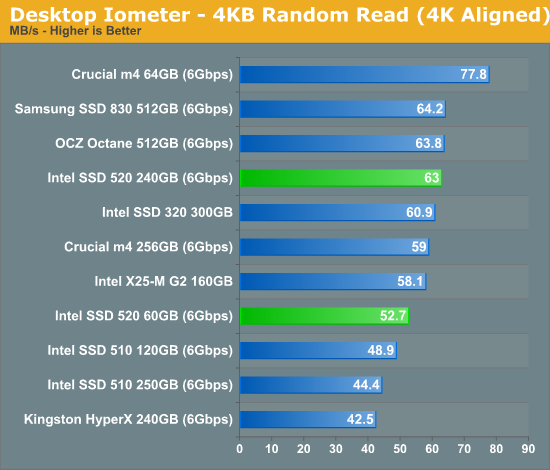
Random read performance seems to have topped out around 60MB/s for most drives and the 520 is no different here.
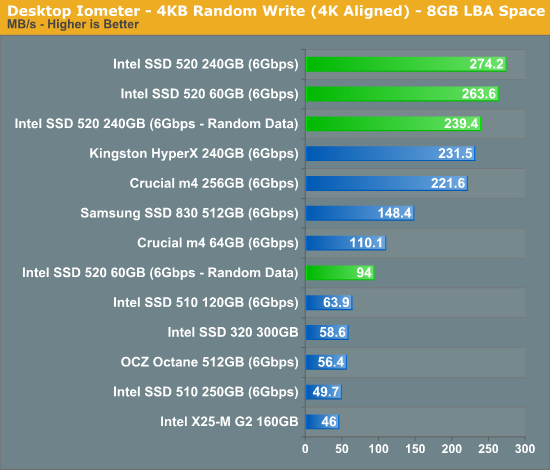
Random write performance, especially with highly compressible data sets the 520 performs beautifully - even outpacing the SF-2281 based Kingston HyperX.
Many of you have asked for random write performance at higher queue depths. What I have below is our 4KB random write test performed at a queue depth of 32 instead of 3. While the vast majority of desktop usage models experience queue depths of 0 - 5, higher depths are possible in heavy I/O (and multi-user) workloads:
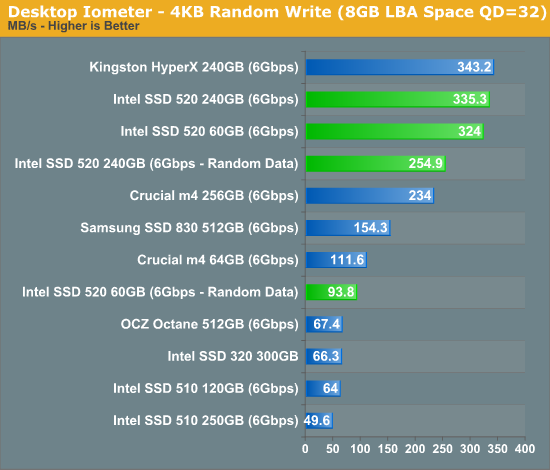
At higher queue depths the HyperX catches up to and surpassed the 520, perhaps indicating that Intel has done some work to optimize low queue depth performance on the 520 (likely what most end users will encounter).
Sequential Read/Write Speed
To measure sequential performance I ran a 1 minute long 128KB sequential test over the entire span of the drive at a queue depth of 1. The results reported are in average MB/s over the entire test length.
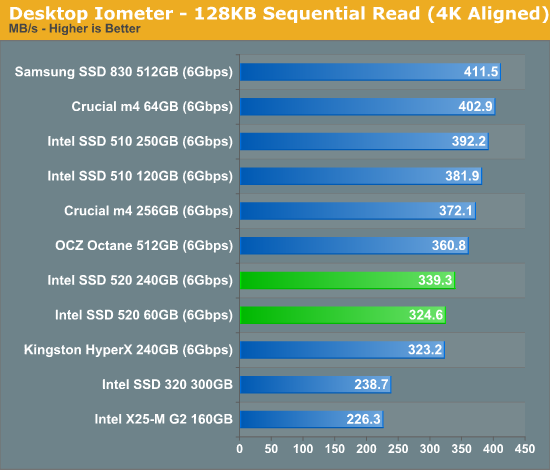
Sequential read performance is actually a bit lower than Intel's 510, but still higher than a standard SF-2281 drive.
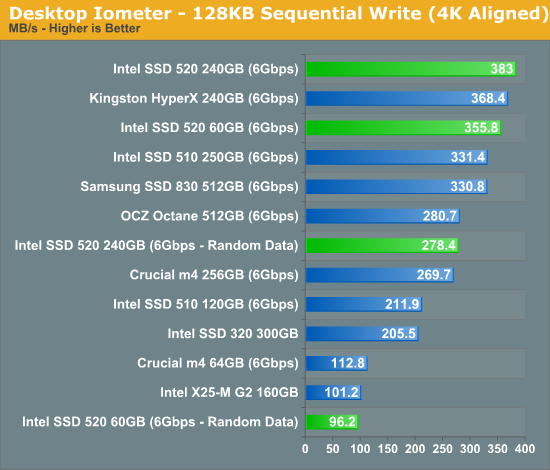
It's important to note just how close the 520's peak random write performance is to its sequential write performance. A big part of this is obviously that the SF-2281 is throwing away a lot of the data it has to write, but even if we compare incompressible 4KB random write to highly compressible 128KB sequential write we see a good ratio. The closer those two values are the more optimal the controller/firmware design is as, in theory, smaller random writes should be grouped to effectively become large sequential writes from the perspective of the NAND.










138 Comments
View All Comments
Sunburn74 - Monday, February 6, 2012 - link
A short, but more indepth article on your findings concerning the BSOD bugs afflicting the Sandforce ssds would be well appreciated by many. The findings of a tech supergenius like yourself would help dispel all the quackery that is floating about concerning what causes it and what doesn't and ultimately will help us all.Shadowmaster625 - Monday, February 6, 2012 - link
"The first possibility is that SandForce has been made aware of flaws in its current firmware and chooses against (or is legally prevented from) disclosing it to its partners"In other words, Intel is possibly forcing a company to sell knowingly defective product to its competitors. That is exactly the type of criminality that I would expect from intel. If this is true then it should be another billion dollars at some point, probably 8 years from now.
Rick83 - Tuesday, February 7, 2012 - link
I don't see any "forcing to sell" happening.I do see in-house development not being given away for free, which is normal business behavior. I'm pretty sure, for the right price, Intel would be willing to share the information.
In fact, the problem lies entirely with SandForce and the people blindly using their firmware, without doing the testing. Yes it's cheaper in the short run, but if you have to deal with a bunch of returns and your name being sullied, it may not pay off.
Also, I remember OCZ having an excllusive deal with SandForce at the start, where they were getting preferential treatment with regards to patches - that's criminal too?
DanSmith - Monday, February 6, 2012 - link
Great article thanks. The documentation on the 520 states it supports AES FDE but judging from my experience with other SF based drives it can be extremely hit and miss, with OCZ for example telling customers on their forum not to use it as it can permanently damage drives!!I hope to read more about AES on the 520 in the real world when you cover SSD's and enterprise soon.
Cheers, Dan
Beenthere - Monday, February 6, 2012 - link
Even after "extensive validation" of their own SSD controller Intel had Bugs and had to issue a firmware update to fix it. I'm not going to be so sure that the SF controller validation is any better than Intel's controller until the 520 series drives have been out in the field for 18-24 months.FunBunny2 - Monday, February 6, 2012 - link
-- until the 520 series drives have been out in the field for 18-24 months.Given the rate of change in SSDland, there'll likely not be any 520s for sale in that time frame.
Beenthere - Tuesday, February 7, 2012 - link
Then it's probably smart to let the guinea pigs suffer thru yet another half-baked SSD instead of wasting our time and money to be unpaid Beta testers for negligent SSD makers. Anand was correct: WAIT 6-12 months to see if they sort out most of the Bugs... He may need to extend that time frame to 36-48 months?As you can see from the numerous comments here, the 520 already has one or more BSOD reports at Intel's support site and people with OCZ and other drives still have issues even after the SandFarce firmware updates. On-The-Job-Training seems to be the current SSD strategy for most if not all SSD companies... which IMO is a disgrace.
FunBunny2 - Wednesday, February 8, 2012 - link
I'm no fan of SF. It's only that SSD land is vastly different from HDD land.FelixO - Monday, February 6, 2012 - link
Hi,I am very tempted to get one of these because I want to shove it in a machine and forget about it for 5 years (rather than upgrade regularly).
However the performance after being filled up is pretty worrying since that it something I do all the time!
Anand, in your SSD reviews you used to talk about what % of the disk was reserved space to help with avoidance of write amplification, or to assist with wear-levelling (or something like that!). You also used to say whether formatting the disk or doing a secure-erase would get you back to peak performance.
You seem to have omitted these discussions from recent reviews.
Any comments on those issues for this drive (Or the Samsung 830)?
Is it possible to adjust the reserved area on these drives? Will that mitigate the problems associated with completely filling the drives? Any comments on running these drives under Linux?
Thanks
4G92 - Monday, February 6, 2012 - link
Can anyone (Anand?) confirm if the Vertex 2 drives have this same Sandforce bug? I know the controllers are different, but my symptoms are EXACTLY the same.I just replaced my Vertex 2 with a Crucial M4 and the problems have now stopped, so I suspect the OCZ drive is the cause of the lockups...